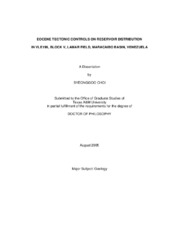| dc.contributor.advisor | Watkins, Joel S. | |
| dc.creator | Choi, Byeonggoo | |
| dc.date.accessioned | 2006-10-30T23:33:26Z | |
| dc.date.available | 2006-10-30T23:33:26Z | |
| dc.date.created | 2005-08 | |
| dc.date.issued | 2006-10-30 | |
| dc.identifier.uri | https://hdl.handle.net/1969.1/4426 | |
| dc.description.abstract | Integrated interpretation of three-dimensional seismic and well-logging
data reveals a prominent “pop-up†structure associated with the VLE 400 fault on
the regional unconformity between the Eocene and Miocene in the VLE 196
field, Maracaibo basin, Venezuela. The VLE 400 fault family, an eastern splay
of the left-lateral Icotea fault in the basin, played an important role in
hydrocarbon migration and accumulation in the field. Hydrocarbons accumulated
to the east of the fault but not to the west. The “pop-up†structure on the Eocene
unconformity has a four -way dip closure, straddling the fault and extending to
the west of the fault. Structures of the Misoa Formation, which is the main
reservoir developed below the unconformity in the basin, differ from the structure
of the unconformity. The structure of the Misoa Formation shows a tilted uplift of
the eastern block of the fault dipping toward the east caused by thrust tectonic
movements. Thrust movement and following strike-slip movements provided additional accommodation space to the west of the fault and generated
expanded thickness of Eocene sediments compared to the area east of the fault.
The thickness of the Misoa Formation east and west of the fault shows no
significant changes. Expanded sediments overlie the Misoa Formation in the
western block in lateral contact with Misoa sediments eastern block act as a
lateral seal.
Ductile movement of the Guasare Formation shale contributed to the
lateral sealing of the fault against the reservoir rocks in the eastern block.
Mobilization of the Guasare Formation modified the structure of overlying
formations including the anticline of the Eocene unconformity.
The growth strata provide useful information of reactivation of e xisting
faults, especially subtle movements which are not recognized by conventional
seismic interpretation. Growth strata isochrons shows subtle reactivation of the
VLE 400 fault family during Miocene time. | en |
| dc.format.extent | 11777547 bytes | en |
| dc.format.medium | electronic | en |
| dc.format.mimetype | application/pdf | |
| dc.language.iso | en_US | |
| dc.publisher | Texas A&M University | |
| dc.subject | Tectonic controls | en |
| dc.subject | Reservoir | en |
| dc.subject | Misoa Formation | en |
| dc.subject | Ductile movement | en |
| dc.subject | Growth strata | en |
| dc.title | Eocene tectonic controls on reservoir distribution in VLE 196, Block V, Lamar Field, Maracaibo Basin, Venezuela | en |
| dc.type | Book | en |
| dc.type | Thesis | en |
| thesis.degree.department | Geology and Geophysics | en |
| thesis.degree.discipline | Geology | en |
| thesis.degree.grantor | Texas A&M University | en |
| thesis.degree.name | Doctor of Philosophy | en |
| thesis.degree.level | Doctoral | en |
| dc.contributor.committeeMember | Ayers, Walter B. | |
| dc.contributor.committeeMember | Berg, Robert R. | |
| dc.contributor.committeeMember | Bryant, William R. | |
| dc.contributor.committeeMember | Dorobek, Steven L. | |
| dc.contributor.committeeMember | Spang, John H. | |
| dc.type.genre | Electronic Dissertation | en |
| dc.type.material | text | en |
| dc.format.digitalOrigin | born digital | en |


